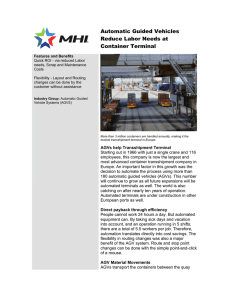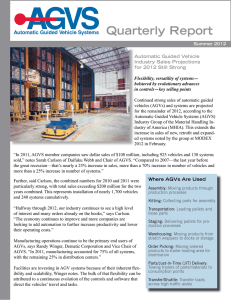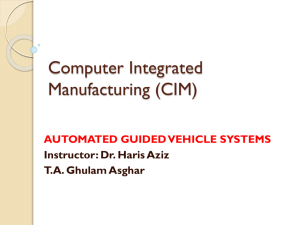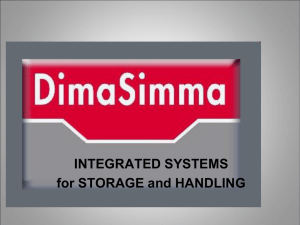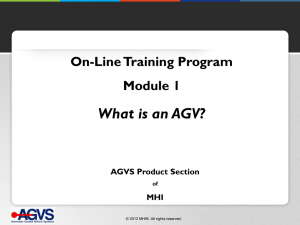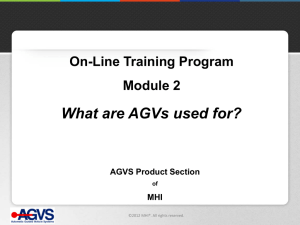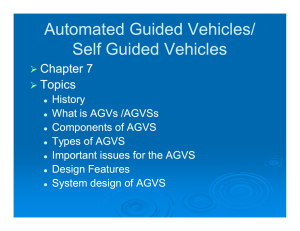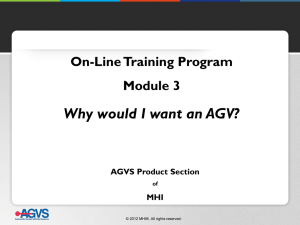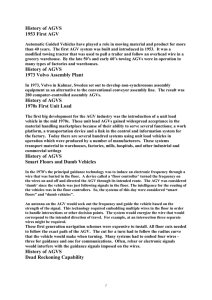Adam Aquino
advertisement
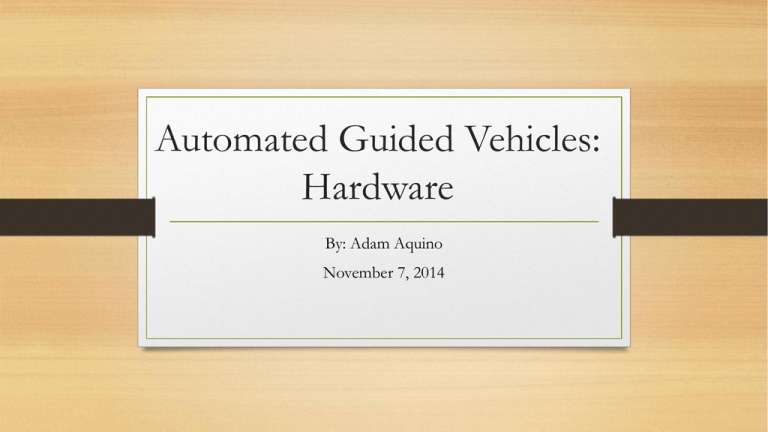
Automated Guided Vehicles: Hardware By: Adam Aquino November 7, 2014 Review • An automated guided vehicle or automatic guided vehicle (AGV) is a mobile robot that follows markers or wires in the floor, or uses vision, magnets, or lasers for navigation. They are most often used in industrial applications to move materials around a manufacturing facility or warehouse. (Wikipedia) • Used in every industry (large factories and storage) • Paper, metals, newspaper, general manufacturing etc. Questions to Consider • Why would certain types of AGVs be preferable over others? • What scenarios are the most appropriate for certain types of AGVs? Overview: History and Current State • First AGV invented by Barrett Electronics in 1954. The term was not introduced until the 1980’s, but was previously known as driverless vehicles. • The first model was a modified towing tractor that followed an imbedded wire in the floor. Sensors on the bottom of the tow truck sensed and responded to a magnetic field from the wires. Overview: History and Current State • Today, the most advanced AGVs are laser navigated (LGV), which are sophisticated and capable of communicated with other robots. Many are navigated using machine vision as well. Ways to Guide AGVs Between Stations • Embedded wire in floor • Good for applications where paths are not going to change • Magnetic Tape on floor • Requires sensors to detect tape path • Less expensive and can be modified • Laser Target navigation • Requires reflective tape on walls and a laser transmitter on a rotating turret on the AGV. • Good for applications where AGV needs to adjust path by triangulating position. • Inertial navigation • Requires transponders embedded in the floor • Extremely accurate (+/- 1 inch) • Operates in tight aisles or extreme temperatures. • Vision Guidance • Requires cameras (records route and “replays” route) • Good for applications where you cannot modify the environment or infrastructure. Types and Uses of AGV’s • • • • • • • Towing Vehicles AGVS Unit Load Vehicles AGVS Pallet Trucks AGVS Fork Truck AGVS Hybrid Vehicles Light Load AGVS AGVS Assembly Line Vehicles Types and Uses: Towing Vehicles • The oldest type of AGV • Pulls a trailer • Good for heavy loads • Range from 8,000 to 60,000 pounds • Can link multiple trailers • Increased Safety Types and Uses: AGVS Unit Load Vehicles • Load rests over the majority of the • • • • vehicle Interfaces with stands and conveyors May be loaded by cranes, forklift trucks, other AGV’s etc. May communicate between loading/unloading machine and AGV (handshake sensor) More complex steering than towing AGVs and more expensive Unit Load Principle Principle • Stored or moved as a single entity at one time, regardless of the number of individual items that make up the load. • Less effort and work are required to collect and move many individual items as a single load than to move many items one at a time AGV Application • AGV just needs a single flat platform to transport a unit load, and unit loads can be stacked on the platform. • Does not need a basket (side barriers) Types and USES: AGVS Pallet Trucks • Transport palletized loads to and from floor level • 2 general types • Automatically reverse into pallets • Operators manually board vehicles and back them into pallets • Automatically reversing a guided pallet truck adds considerable expense. • Manually loading pallet trucks are more common. Types and USES: AGVS Fork Trucks • “Used when the system requires automatic pickup and drop off loads from floor or stand level and where the heights of load transfer vary at stop locations.” • Conveyers or load stands of different heights can all be serviced • Most expensive of AGVS types • Harder to move large loads • Requires more precise movement. Types and Uses: AGVS Hybrid Vehicles • “Adapted from a standard CAT-style man-aboard truck so that they can run fully automated or be driven by a fork truck driver. These can be used for trailer loading as well as moving materials around warehouses.” (Wikipedia) • Customizable for most load types. • 25 – 30% cheaper than standard AGV’s • High Flexibility Types and USES: Light-load AGVS • 500 pounds or less • Transport small parts to individual work locations • Trays/baskets • Good for small and tight areas • Applications include electronic fabrication, small assembly manufacturing and parts kitting applications Types and Uses: AGVS Assembly Line Vehicles • Similar to light load AGVS • Good for applications involving serial assembly processes • Cary subassemblies such as motors or transmissions • Allow for parallel operations • Allow for individual tracking and measured work rates • Require extensive planning COSTS Level 1: Simple Manual Vehicle Dispatch, Load/Unload, No Central Controller, No Host Interface. Level 2: Medium Automatic Vehicle Dispatch, Load/Unload, Central Controller, Product Tracking, Multiple Path Options. Level 3: More Automatic Vehicle Dispatch, Load/Unload, automatic coupling/uncoupling (applies to tuggers only), Central Controller, Complex Host Interface, Ethernet Link, Product Tracking, Multiple Path Options Multiple Transfer Heights, etc. Primary Vendors • • • • • • Savant Automation, Inc. America in Motion Ward Systems, Inc. Egemin JBT Corporation TecnoFerrari/Prella Technologies Supporting Technologies Technical Paper: Modelling battery constraints in discrete event automated guided vehicle simulations • Author: R. McHANEY • Purpose: • AGV battery usage is frequently omitted in simulation because battery constraints are mistakingly believed to have minimal impact on throughout and the number of vehicles required to operate a system, many simulation analysts do not have a full understanding of how batteries are used to power AGVs, and battery analysis requires additional input information and varies from vendor to vendor. • Main Takeaway • Do not ignore battery considerations. They are important. Video • https://www.youtube.com/watch?v=33XpgfppjtE Standards ANSI/ITSDF B56.5-2012 - Safety standard for Driverless, Automatic Guided Industrial Vehicles and Automated Functions of Manned Industrial Vehicles - Applies to system suppliers, manufacturers, purchasers and users for the design, construction, application, operation and maintenance of UGVs Example • The AGV’s in the figure include load station 1 where raw parts enter the system for delivery to any of three production stations 2,3, and 4. Unload station 5 receives finished parts from the production stations. Load and unload times at stations 1 and 5 are each 0.5 min. Production rates for each workstation are indicated by the delivery requirements in Table 10.5. A complicating factor is that some parts must be transshipped between stations 3 and 4. Vehicles move in the direction indicated by the arrow in the figure. Determine the average delivery distance, L₂. Example 9 50 +5 120 +6 205 +9 80 +2 85 +3 170 +8(85) 9+5+6+9+2+3+8 4,360 = 42 Ld= Ld= 103.8 m Summary: Main Takeaways • The type of AGV you use is highly dependent on the layout of the workspace • AGVs are highly dependent on specific types of sensors, which depend on the application and type of navigation that the AGV uses. Sources • • • • • http://www.agvsystems.com/faqs/ http://www.agvsystems.com/ http://www.mhi.org/agvs/cost-estimating http://www.agvsystems.com/tow-vehicles/ http://www.jbtcagv.com/en/Solutions/Products/Unit-LoadAutomatic-Guided-Vehicles-AGVs • http://www.mhi.org/media/news/11614 • http://www.agvsystems.com/agvsbasics/basics-agvs/#fork
